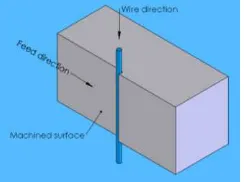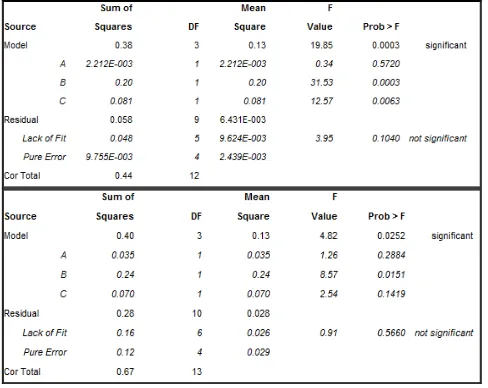<
講演番号
>
生産システム部門研究発表講演会2015・’15.3.16
Copyright © 2015 一般社団法人 日本機械学会
Modelling and Optimization of Cutting Parameter during Wire-EDM of Inconel 718 using
Response Surface Methodology
Mohd Shahir Kasim
Universiti Teknikal Malaysia Melaka
Nor Fakhriah Zakaria Universiti Teknikal Malaysia Melaka
Che Hasan Che Haron Universiti Kebangsaan Malaysia Jaharah Abd Ghani
Universiti Kebangsaan Malaysia
Raja Izamshah
Universiti Teknikal Malaysia Melaka
T Joseph Sahaya Anand Universiti Teknikal Malaysia Melaka Teruaki Ito
The University of Tokushima
A study on the relationship between wire electrical discharge machine (WEDM) parameters and surface finish are presented. This study analyzed the relationship between cutting parameter as variable input and surface roughness as output. To optimize the surface roughness which was measured both in horizontal and vertical direction, a Box Behnken of response surface methodology (RSM) with three process parameters; voltage, current and feed rate are used. Analysis of variance (ANOVA) was used to study the identified parameters that affecting the machined surface finish. With the results of P-Value and F-Value, machining voltage is known as the most contributing factor, followed by current and feed rate. The direction of measurement was found to be less significant. The linear prediction models were developed with average error of 3.67% and 1.74% horizontal and vertical surfaced roughness measurement direction respectively. The result of the validation also shows a good agreement with predicted values. It is beneficial as to assist machinist in improving the quality of the WEDM surface.
Key Words: WEDM, Inconel 718, Process Optimization, Surface Roughness, Analysis of Variance
1. Introduction
Surface roughness is the one of the prominent criteria that plays an important role in determining quality of the product. It has undesired impact on the mechanical properties like poor fatigue behaviour, short creep life, poor corrosion resistance, etc. [1]. For conventional cutting condition, irregularity of machined surface is left by cutting tool. The uncut region during cutting tool motion which controlled by feed rate affected the quality of surface finish. Some researchers found the deterioration of cutting tool geometry also affected on machined surface [2]. Conversely for non-contact cutting process of wire electrical discharge machining (WEDM), the surface roughness is inherent by the formation of cavity by means of thermo-electro spark. This spark is dominantly controlled by voltage and current [3].
Inconel 718 is well known material that hard to machine. It is widely used in aircraft engine component (blade and disc) due to its good mechanical and chemical properties [3]. The popular approaches in producing these components are by milling and broaching processes [5]. However, related literatures reported on poor machinability of this material due to short tool life [6]. WEDM is another alternative in material removing process. Taking advantage of its high accuracy and non-contact cutting process, many researches were carried out. However, the application of WEDM associated with Inconel 718 is less to be highlighted. Klocke et al., 2012 studied on cutting of fir tree slots in turbine discs. They presented that surface integrity with low surface roughness, high accuracy and normal residual stress can be achieved by WEDM and thus meet the turbine manufacturing requirement [5]. Welling reported that WEDM process in fatigue resistant surfaces is comparable with broaching and grinding manufactured surfaces [7]. It also reports the effect of WEDM parameter on surface roughness during machining of Inconel 718. This work investigates on both direction of measurement as vertical and horizontal. The mathematical model of surface roughness to be developed using response surface methodology (RSM) and to identify the optimized parameter for WEDM in minimizing machined surface roughness also focused.
2. Methodology
The material used in this WEDM study was double aged Inconel 718 grade AMS5663 with the hardness of 44 ± 2 HRc. The
chemical compositions were 53% Ni, 18.30% Cr, 18.7% Fe, 5.05% Nb, 3.05% Mo, 1.05% Ti, 0.23% Mn and C balance (% wt.). All tests were done in a Mitsubishi WEDM RA90 Series. The brass wire 0.25 mm of size was used throughout this experiment. The dimension of the block was cut into 10 x 25 x 160 mm rectangular blocks. The sample was cut in straight line. The surface roughness of cutting area was measured using a portable surface roughness tester (SJ 301). The arithmetic average value of surface roughness, Ra, was set throughout the experiment. The measurement was repeated 10 times on horizontal (feed direction) and vertical (wire direction) for every sample (Fig. 1). The WEDM process was carried out with the cutting parameters namely feed rate, voltage and current as denoted by term A, B and C respectively. Details of cutting parameter were feed rate (0.5 – 1.5 mm/min), voltage (40-42V) and current (6 – 8A). The experimental results were analyzed with response surface methodology (RSM) as design of experiment tool. This experiment involves three factors and three levels, hence, the number of trial done was 17 including 5 of center points. Analysis of variance (ANOVA) was used to identify the most significant factor where the P-value of cutting parameter is less than 0.5.
Fig. 1 Measurement direction setting on machined surface
3. Results and Discussion
The measured machined surface roughness is shown in Table 1. It was noticed that there are minimal deviation between surface roughness in feed direction (horizontal) and along wire direction (vertical). Due to the number of deviation is too small, it is hard to identify the factor that effect on both surface directions.
ANOVA for Ra horizontal shows the lack of fit is significant and Ra vertical shows the model is not significant. As to improve these models, some outliers marked with * were omitted from the data set. Outlier is the actual value deviates from the value predicted where it can be detected by Cook’s distance plot. The improved ANOVA is shown in Table 2. It was found term B (voltage) is dominantly control surface roughness in both horizontal and vertical directions. Term C (current) only significant on horizontal direction and term A (feed rate) found to be not significant on both Ra directions.
Table 1: Parameter and result of surface roughness on horizontal and vertical direction
PARAMETER SURFACE ROUGHNESS
RUN
Feed Rate mm/min
Voltage Volt
Current Amp
Ra Horizontal µm
Ra Vertical µm
1 0.5 42 7.0 2.948 2.623*
2 1.5 41 6.0 3.132 2.863
3 1.0 40 6.0 2.750* 2.932*
4 1.0 40 8.0 3.492 3.567
5 1.0 41 7.0 3.118 3.129
6 1.0 42 6.0 2.670 2.806
7 0.5 41 6.0 2.921 3.108
8 0.5 41 8.0 3.202 3.339
9 1.0 41 7.0 3.239 3.511
10 1.5 40 7.0 3.108* 3.343
11 1.0 41 7.0 3.127 3.295
12 1.5 41 8.0 3.159 3.048
13 1.0 41 7.0 3.173 3.088
14 1.0 42 8.0 3.028 2.963
15 0.5 40 7.0 3.066* 3.005*
16 1.0 41 7.0 3.138 3.340
17 1.5 42 7.0 3.300* 3.124
*outlier
Table 2: ANOVA for Ra on feed direction (horizontal) and wire direction (vertical)
3.1 Model development
From the ANOVA, a statistical equation model has been developed to estimate the surface roughness using normal model transformation. Prediction of Ra value can be denoted by the first-order model which shown in Equation (1) and (2):
Rahor = 12.388 + 0.043A – 0.246B + 0.111C (1)
Raver = 11.777 - 0.156A – 0.223B + 0.102C (2)
Both equations were tested with actual experiment in Table 1. The average error found for Ra horizontal and Ra vertical are 1.74% and 3.67% respectively.
The validation process helps to clarify whether the developed model is producing a reliable result that can be accepted and used to support for decision making. The process is done by checking the difference between the prediction result from mathematical model and actual experimental result. The error is less than 10% which is acceptable as suggested by [8]. The combination of cutting parameter; feed rate = 1.0 mm/min, voltage 41 V and current = 7 A is chosen with the error model as 6.63% and 1.51% for Ra horizontal and Ra vertical.
The optimization process is to determine combination of cutting parameter so that the lowest Ra of both directions is minimized. The optimized cutting parameter of 2.797 μm and 2.806 μm (Ra horizontal and Ra vertical) can be achieved by the combination of feed rate = 1.44 mm/min, voltage = 42V and current = 6A.
4. Conclusions
This paper shows the cutting parameter that contributing to Ra. It was found that voltage dominantly control on Ra of both direction. Current is only significant on horizontal direction (Ra on feed direction) and feed rate is not statistically significant. A mathematical model based on RSM method has been successfully developed with the average error of 6.63% and 1.51% for Ra horizontal and Ra vertical. The Ra difference between horizontal and vertical direction found to be minimum.
5. Acknowledgement
The authors acknowledge the support from TMAC of Universiti Teknikal Malaysia Melaka and University of Tokushima, Japan. Special Thank to Universiti Kebangsaan Malaysia for supplying raw material.
6. References
[1] P. Sahoo, T. Barman and J. P. Davim, Fractal Analysis in Machining. New York: Springer, (2011).
[2] E.O. Ezugwu and C.I. Okeke, Threading of inclusion modified steels with coated carbide tools. Key Engineering Materials, Vol. 196 (2001) 177-192.
[3] G. Singh, P. Singh, G. Tejpal and B. Singh, Effect of Machining Parameters on Surface Roughness of H13 Steel in Edm Process Using Powder Mixed Fluid, International Journal of Advanced Engineering Research and Studies Vol. 2,(2012) pp. 148-150
[4] D. Ulutan and T. Ozel, Machining Induced Surface Integrity in Titanium & Nickel Alloys:A Review, International Journal of Machine Tools & Manufacture Vol. 51 (2011) p. 31 [5] F. Klocke, D. Welling, J. Dieckmann, D. Veselovac and R.
Perez, "Developments in Wire-Edm for the Manufacturing of Fir Tree Slots in Turbine Discs Made of Inconel 718," in 15th Conference of the European Scientific Association on Material Forming, ESAFORM 2012 Vol. 504-506, ed. Erlangen, 2012, pp. 1177-1182.
[6] M. S. Kasim, C. H. Che Haron, J. A. Ghani, A. I. Gusri, M. Z. A. Yazid and M. A. Sulaiman, Tool Life of Tialn Pvd Coated Carbide Tool in High-Speed End Milling of Untreated Inconel 718 under Minimum Quantity Lubrication Condition, Sains Malaysiana Vol. 42 (2013), pp. 1721-1726
[7] D. Welling, Results of Surface Integrity and Fatigue Study of Wire-Edm Compared to Broaching and Grinding for Demanding Jet Engine Components Made of Inconel 718, Procedia CIRP Vol. 13 (2014) pp. 339-344

